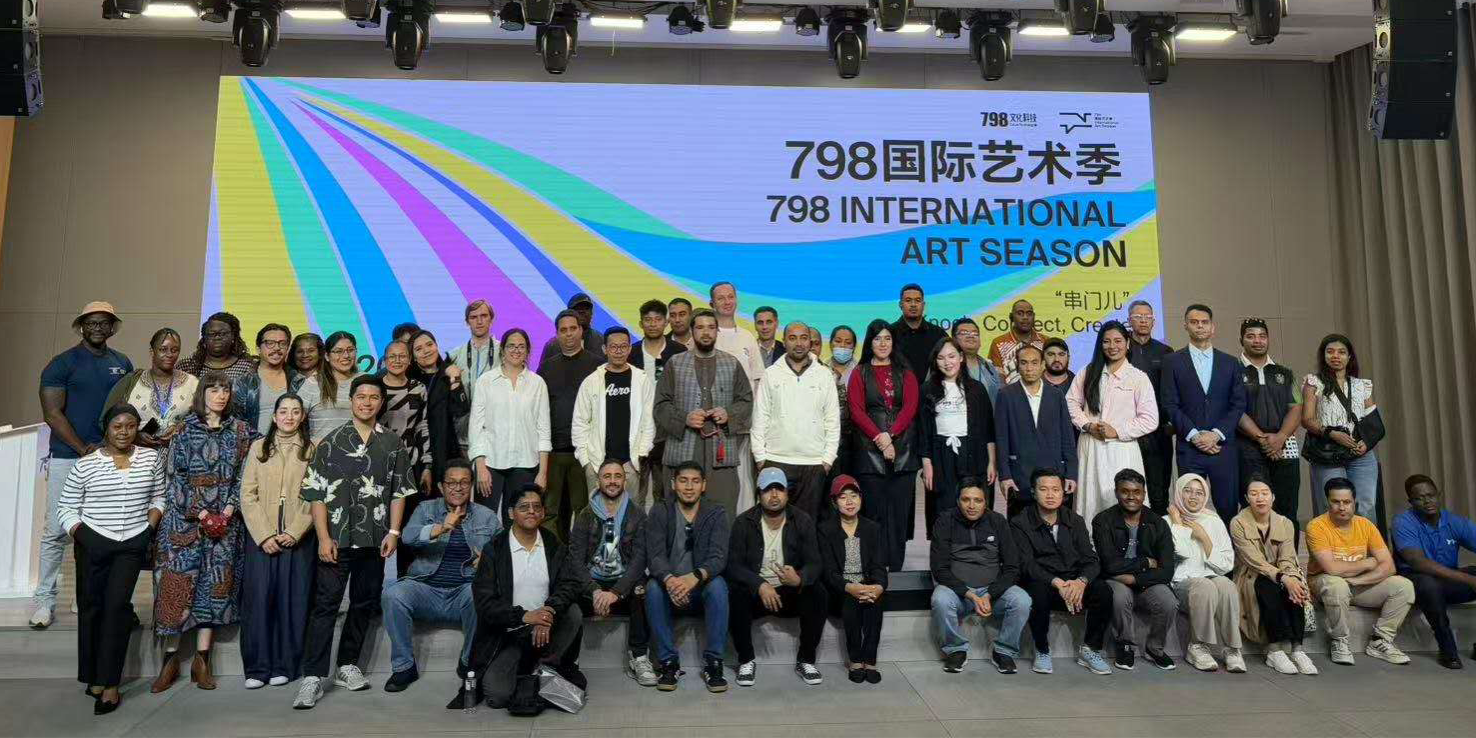BEIJING’S 798 Art District and 751D·Park are significant reminders of the Chinese industrial history and the emergence of the former as a cutting-edge art hub and the latter as frontier for fashionable culture have placed them amongst the top visit destinations in the Chinese capital.
The 798 Art District and 751D·Park are located in what was once the Beijing North China Wireless Joint Equipment Factory constructed in 1952 with aid from the former German Democratic Republic.
The 798·751 zones span over 500,000 square meters, with the iconic Bauhaus factory architecture alone covering more than 70,000 square meters. It is home to over 600 institutions across a wide range of fields, including art, design, film and theater, media, technology, fashion, automotive, architecture, music, entertainment, and cultural dining.
Nearly 80 per cent of these institutions are dedicated to cultural and creative industries, encompassing national cultural communication centers, international cultural and art organizations from 19 countries and regions, as well as renowned institutions blending traditional and contemporary Chinese art.
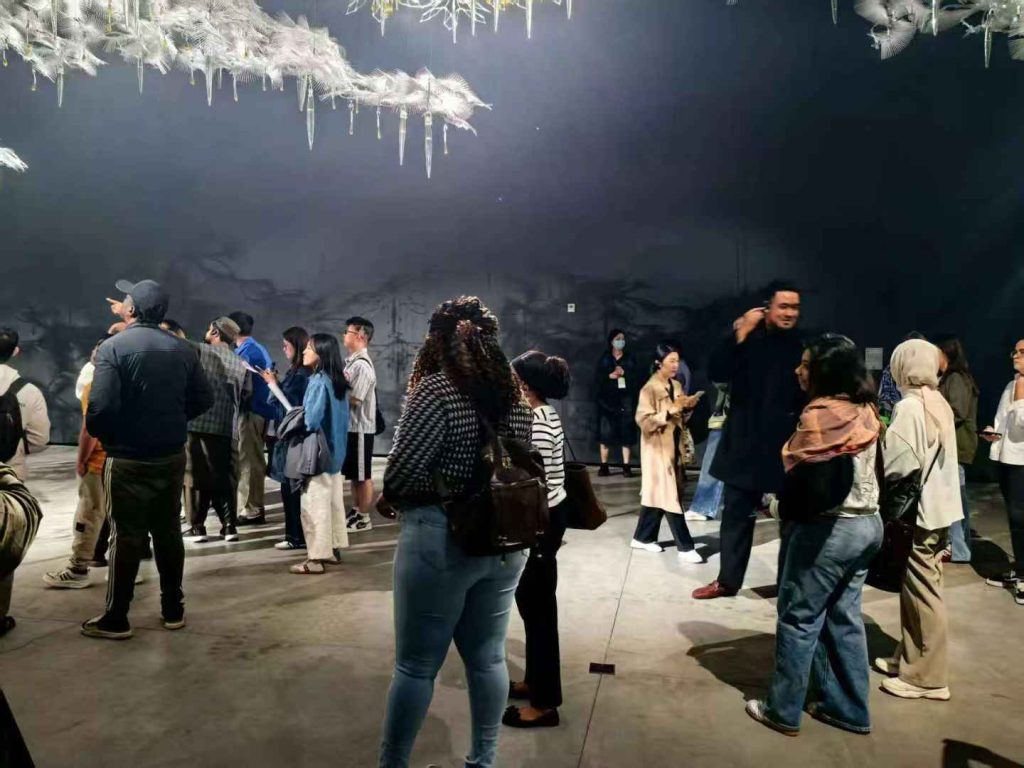
International journalists on a media exchange program in China visited the 798 Art hub on Thursday 22 May. The vastness of the art hub and the 751 fashionable culture exhibitions, did not render us time for a complete visit.
As was introduced to us, the Beijing 798 Culture and Technology Co. Ltd, a cultural and creative industry operator under state-owned enterprise Beijing Electronic Holding Co. Ltd, runs operates the art and fashion hubs.
The company has leveraged the high-quality resources of the 798 and 751 spaces, brands, traffic and intellectual properties based on a development philosophy centered on cultural attraction, technological platforms and capital empowerment.
The company innovated the ‘space operation + IP development + digital services’ model, which promotes the integration of culture, commerce, and tourism through effective management.
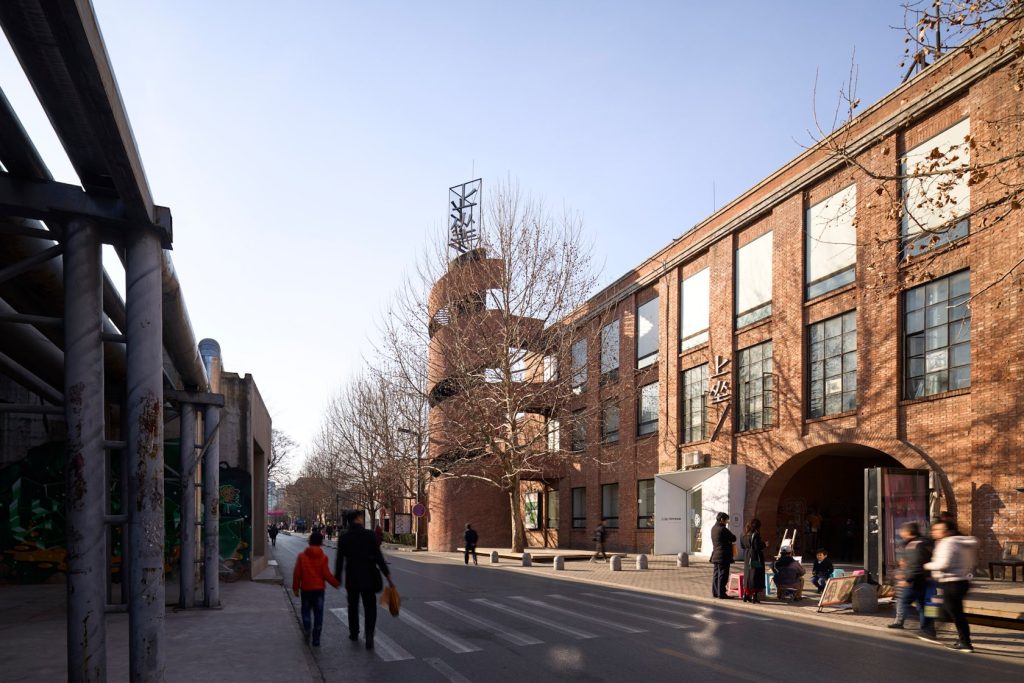
This model has enhanced cultural value dissemination and harnessed digital technology to enable diverse cultural expressions with the objective of shaping a new model of cultural and artistic innovation, and it led to the creation of one of the most creative cultural technology industrial groups.
The 798-751 community hosts nearly 100 prominent artist studios from both domestic and international circles and each year, and also hosts thousands of cultural and art events, solidifying its status as the largest cultural industry cluster in China focused on art.
It received a total of 12.57 million visits in 2024, with international tourists accounting for as much as 30 per cent of the total. Furthermore, over 200 heads of state and government officials from around the world have visited the community, drawn by its reputation.
The art exhibitions we visited, included the One Tree ID, Orbihedron Visual Experience, Bouquet Final, Constellation, Dense No.9, the Ghoul, Swinging Gray, 20 Hz Semiconductor, Random Access Memory, Aquaphoneia and Tang Contemporary Art Center. These exhibitions were intriguing and immersive, taking us into the creative thinking of their creators.
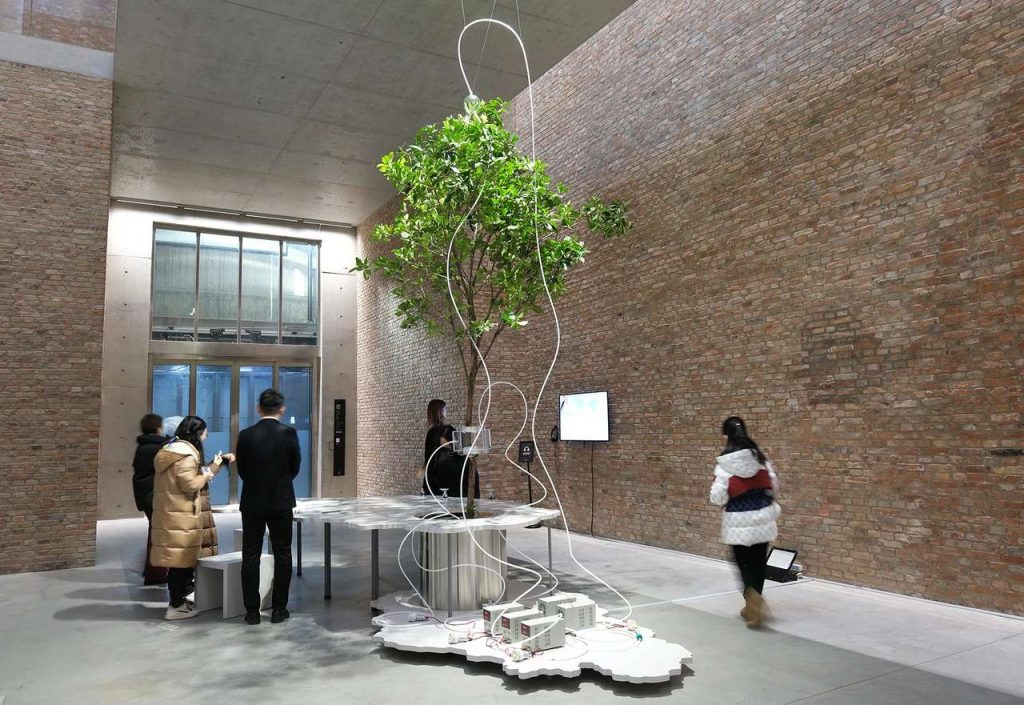
One Tree ID – How to Become a Tree for another Tree
This art work, by German artist Agnes Meyer Brandis, showcases how the ID of a tree is transformed into a perform. By applying this perfume, a person can invisibly wear the characteristics of the tree, and also use parts of the tree’s communication system to converse – not visibly and audibly but at the biochemical level that plants use for information exchange.
Orbihedron Visual Experience
This visual experience art piece, by Evelina Domnitch of Belarus and Dmitry Gelfand from Russia, allows visitors to immerse in a sonic and visual experience representing the formation of a black hole, which offers profound insight into quantum physics and the cosmos.
This installation piece uses ‘On Time Out of Time’ feature recordings from Laser Interferometer Gravitational-Wave (LIGO) composed by William Basinski.
It presents a quantum presentation of gravity, mimicking a black hole formation through a new model developed specifically for this work.
The immediacy of this experience allows the observer to transcend the illusion distinction between scientific discovery and perceptual expansion.
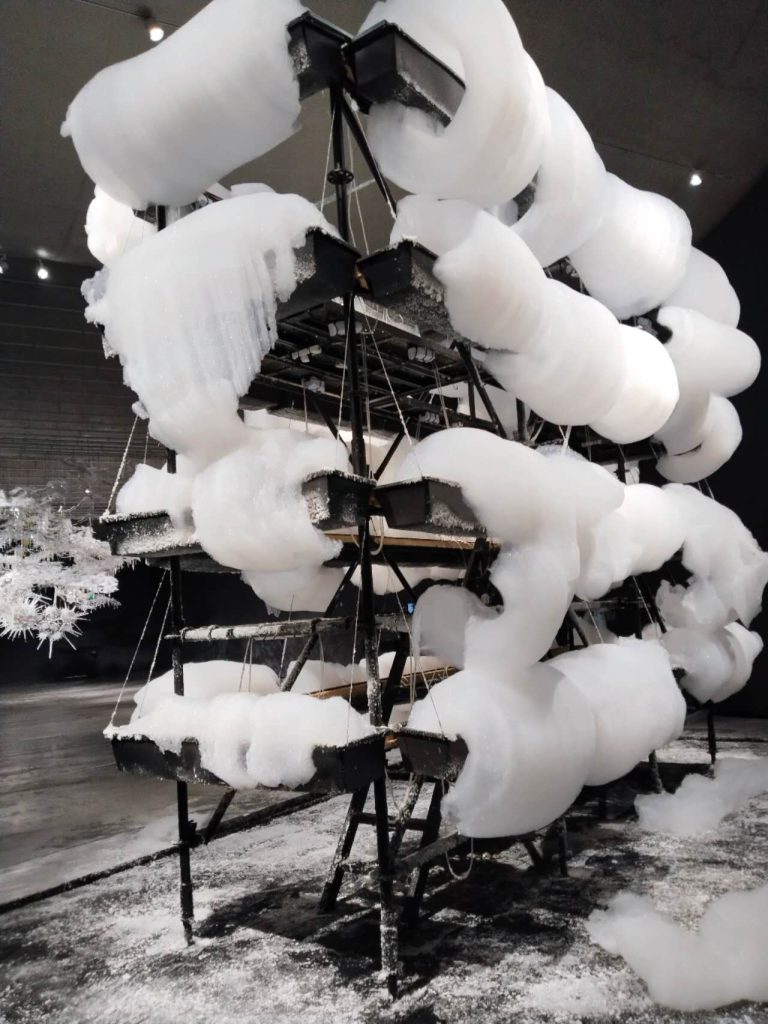
Bouquet Final
This art piece by French conceptual artist Michel Blazy displays foam, an ephemeral substance.
Emerging from a tall, metal structure, the sensational frothy material spurts forth. This free-flowing changeable matter moves as a sheet that curls as it grows longer.
The foam is produced by a generator that creates a muffled noise from behind the installation. The physical qualities of this installation point to an instance in which art cannot be preserved. Foam is a varied experience in Blazy’s oeuvre, oozing from structures such as garbage bins and planters.
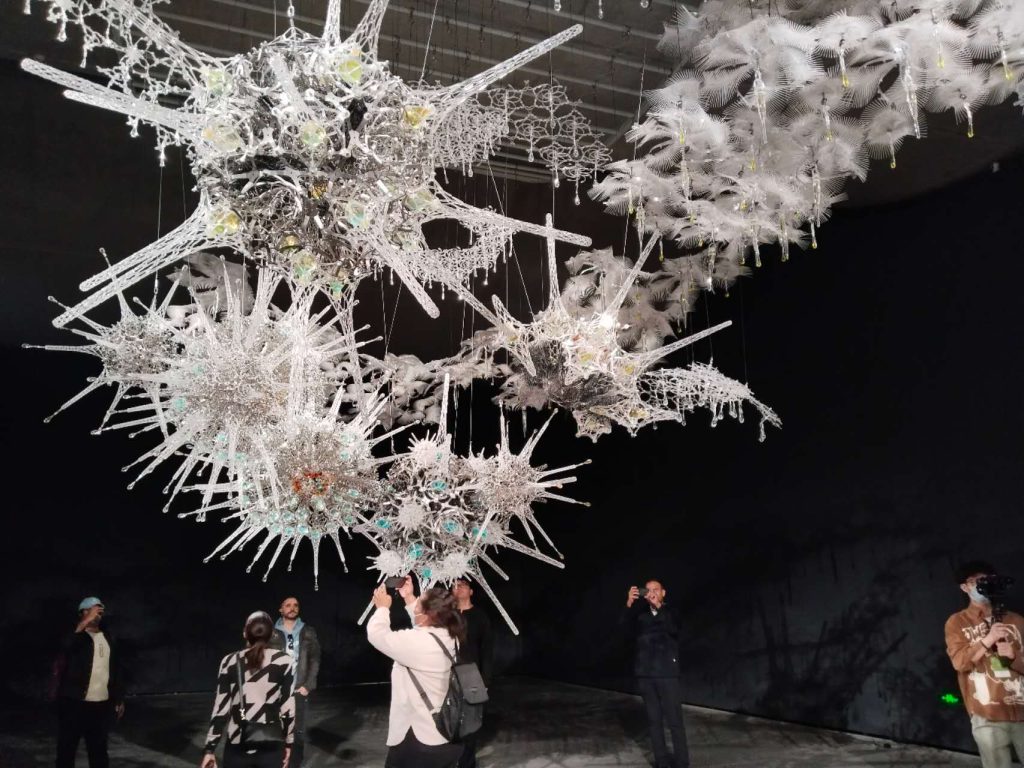
Constellation
This art piece, by Canadian artist Philip Beesley in collaboration with industrial designers, engineers and couture artists, offers a soaring, undulating canopy of luminous lace-like clouds embedded with liquid-filled protocell glass vessels.
The clouds surround a suspended beacon-like central cluster of radiant spherical sheltering nest forms. The delicate materials hover, reaching up high and creating delicate shadows. Deeply fragmented vibration-like filamentary forms are interwoven with shimmering light.
Beesley and his collaborators offer a vision of a transformed world where future architecture seeks communion with plants, animals and inert matter alike. The extraordinary complex interior worlds of this constellation of cells offers an immersive vision of new life arising.
Dense No.9
This art piece by Chinese Wang Jianwei is created out of his dissatisfaction with what he saw as the closed system of contemporary art where works are understood through vision and words only.
Jianwei produced deliberate unclassifiable ambiguous work through which he aims to reflect the fullness of the world – a place where many different things, opposite things are juxtaposed.
Since 2000, Wang has combined a multitude of media, including performance, sculpture and video to create installations meant to be experienced as expressions of ideas and questions about art, society and history, rather than as fixed, concrete objects.
Random Access Memory
This art piece by Ralf Baeker is a fully functional digital memory. Instead of operating with semiconducting components to represent either binary states of zero or one, the memory uses grains of sand as storage material.
Sand grains can be read, placed or removed on a rotating disc by a three-axis pick-and-place mechanism combined with a microscope camera to track the position of a single grain of sand. This memory mechanism is prone to errors due to misreading, bouncing grains and other imponderables.
The Ghoul by Cod.Act
In an age when the virtual world is becoming so prominent in everyday life, especially in the Western cultures where fewer and fewer activities and jobs involve physical activity such as agriculture or manufacturing, this fascinating work focusses on the mechanical and physical.
Cod.Act is one of the most renowned names working in new media and kinetic art nowadays. Their works include performances and complex interactive installations.
It is the creation of two Swiss Décosterd brothers André, a musician, composer and programmer and a specialist in sound applications and algorithmic composition, and Michel, an architect specialised in the treatment of plastic and self-taught mechanical engineer.
It emerged from their obsession with sound and mechanical movement.
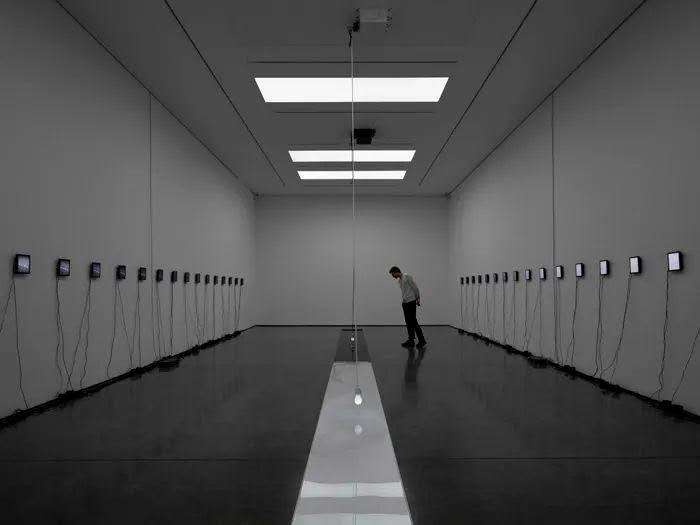
Swinging Gray
This installation piece by Chinese Wang Gongxin consists of two glowing 3D-printed light bulbs, each of which is fitted with a video camera and swing like pendulums across pools of water, one dyed black and the other white.
As the bulbs skim the pools, they affect the illumination of the surrounding space, while the cameras capture visitors from constantly changing angles. After these images are sent by live feed to either side of the gallery’s wall, visitors are able to themselves on camera.
Wang had a very specific vision for this piece, which explores
20 Hz semiconductor
This is a workpiece by Ruth Jarman and Joe Gerhardt of the United Kingdom.
It is a moving image work by semiconductor created using data of the Earth’s magnetic field as a geo-magnetic storm occurs in the Earth’s upper atmosphere.
The incoming solar wind captured at the frequency of 20 Hertz causes tweeting sounds and rumbles.
Random Access Memory
This is a fully functional digital memory work by German Ralf Baeker. Instead of operating with semiconducting components to represent either the binary states of zero or one. The memory uses grains of sand as storage material.
Sand grains can be read, placed or removed on a rotating disc by a three-axis pick-and-place mechanism combined with a microscope camera to track the position of a single grain of sand. This memory mechanism is prone to errors due to misreading, bouncing grains and other imponderables.
The machine performs a computational process on this memory. The algorithm, executed on the sand grains, is a so-called Turmite, a two-dimensional operational Turing Machine.
Its only goal is to write as many stones as possible in the memory and to avoid termination following a strict rule. This process produces a complex and repetitive pattern on the disc.
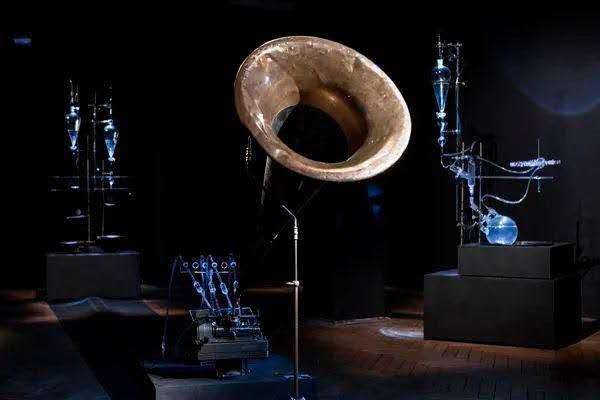
Aquaphoneia
This is an alchemical installation piece by Tehran born and raised Navid Navab centres around the poiesis of time and the transmutation of voice into matter.
A large horn mid-space echoes the ghost of Edition’s machine. This odd assemblage transmutes voice into water and water into air, and vocal sounds falling into the depths of the horn are calcinated and liquified.
The aqueous voice then flows into three alchemical chambers where inner time is surrounded to the tempi of matter – unbound, yet lucid and sound.
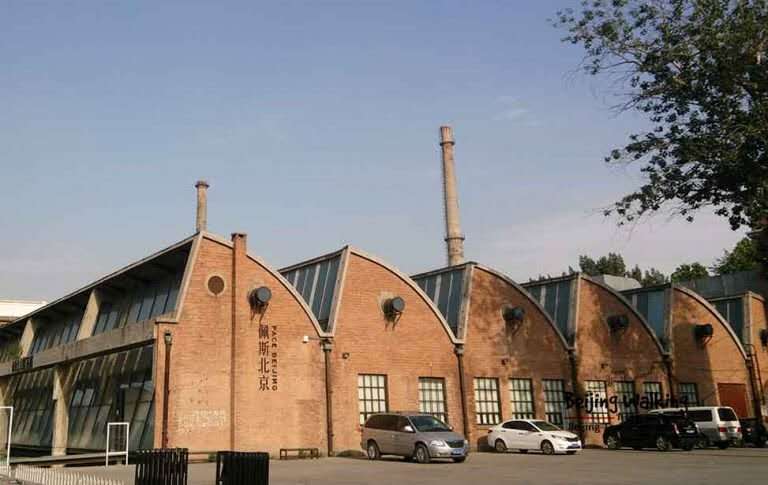
Tang Contemporary Art Center
Tang Contemporary Art Center, established in Bangkok in 1997, has since expanded to eight locations across Beijing, Hong Kong, Bangkok, Seoul, and Singapore, actively promoting experimental art across diverse regions.
Over the past two decades, the center has not only hosted pioneering exhibitions in its own spaces, but has also collaborated with prominent art institutions both domestically and internationally to realize outstanding art projects.
Dedicated to fostering exchange and dialogue, Tang Contemporary Art Center serves as a platform connecting local and international artists, curators, collectors, and art institutions.
As one of China’s most academically influential contemporary art platforms, it has garnered high praise internationally through its groundbreaking exhibitions and art projects, solidifying its status as a pioneer in Asian contemporary art.
Key takeaway from this visit
The vibrant 798-751 art and fashion culture zones serve as a model of industrial heritage reuse, and are a reminder of China’s remarkable journey as an aid recipient nation with a humble industrial beginning to a nation of global economic prominence.
China’s leverage of the former factory zones into international art and fashion hubs is a shining example of strategic economic development thinking. The former factory building-turned art and fashion hubs host prominent local and international artists and fashion designers for the exhibition of their works, attracting visitors from home and abroad, which in turn is a boost to China’s tourist industry and economy.
China has seen a significant surge in inbound tourism, with the total number of inbound tourists reaching 94.6283 million in the first three quarters of 2024, marking a 78.8 percent increase year-on-year.
The thriving status of the 798-751 art and fashion culture zones also exemplify good management by their operator and the efficiency of China’s State-Owned Enterprises and the significant role they play in national economic success.
By DELI-SHARON OSO
In Beijing, China

